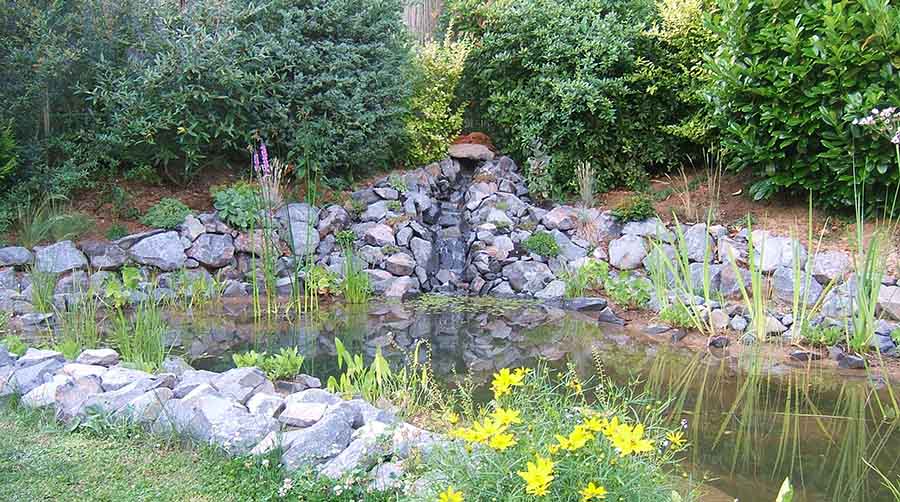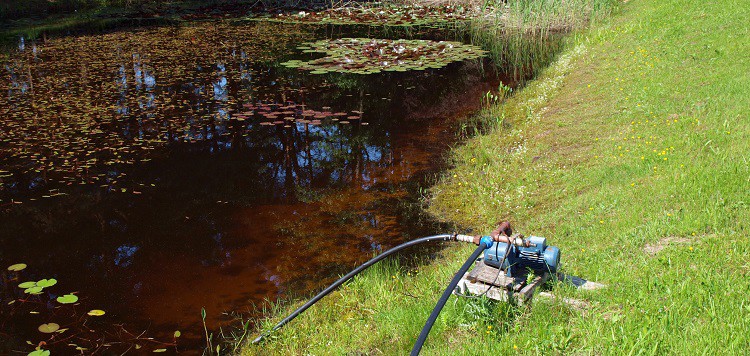Pond pumps come in a variety of sizes with different flow rates. Some pumps move more water than expected, some move less. It can be tricky to find the right sized pump for your pond.
A pond pump can be too big for the size of pond, causing excess water loss, increased energy usage, an uncomfortable noise level, and an unsuitable environment for plants or fish. Careful calculation of your pump needs before purchase will help to avoid future difficulties.
There are many factors to consider when selecting a pump. The size and depth of the pond must be considered, as well as whether there are attached features such as a cascade or waterfall. You must also take into consideration whether you will stock the pond with fish, what kind of fish, type of filter, etc. In this article, we will look at some of the variables that will impact your pump selection.
What Happens If A Pond Pump Is Too Big?
How do you know if your pump is too big? You will notice a spray of water, most of which will drop onto the ground surrounding the pond instead of settling back into the pond itself. A pump that is too big will shoot the water too high because of too much force.
If you notice that your pond is
- Gushing
- Splashing
- Turbulent
- Losing Water Volume
- Too Loud
It may be an indicator that you could use a smaller pump.
Shooting Spray Is A Sign
Most ponds are meant to gurgle and laugh over rocks or trickle down through a waterfall. If your pond resembles a geyser or a firehose instead, you may want to consider reducing the size of your pump or using a splitter to divert some of the water away from the pump.
High Noise Level Shouts It Out
A pump that is too big for its pond, will create a lot of noise as well as a lot of mess. If your neighbors need a megaphone to communicate with you, it could be a sign that your pump is a bit oversized. You want a quiet, peaceful spot; not Niagara Falls.
Increased Energy Usage Highlights A Problem
Too-large pumps will also eat up a lot of energy unnecessarily. An unusually high electric bill could be a tip-off that your pump should be smaller.
Turbulence Can Injure Your Fish and Plants
A pump that is too big will churn the water more violently than necessary which can cause injury to any plants or fish that you may have in the pond. The water only needs to be circulated, not heaved. If you notice your plants or fish getting thrown around a little too forcefully, it probably means your pump is a bit extra.
How Big is Too Big?
Figuring out what size pump is appropriate for your pond can be a challenge, especially if math isn’t your strong suit. But luckily, it’s not rocket science.
As a rule, your pump and filter sizes should be equal to your water volume. So, if you have a 1,100-gallon pond, you need a 1,100 GPH pump and a 1,100-gallon filter. This allows for the recommended once-every-hour turn-over without overwhelming either your pump or filter.
If your pump’s capacity is less than your water volume, all the water will not be circulated through the pump as often as it should be, resulting in a build-up of algae and organic wastes.
If your pump’s capacity is more than your water volume, in addition to splashing much of the water out of the pond, it could put a lot of pressure on your filter as the pump tries to push more water in than the filter is capable of processing. This can cause back-up in the pump.
Rules Are Made to Be Broken

The exception to this rule is when there are attached features to the pond, such as a waterfall or cascade. Then your pump needs to be a bit larger to get the water all the way to the top of the waterfall or cascade in a flow rate that is more than a slight trickle.
Similarly, when the pond is stocked with fish, especially Koi, the pump capacity should be a bit more than the water volume to ensure that all the waste is removed efficiently.
How to Calculate The Size Pump You Need
Pump size is calculated based on several factors, including:
- type of pump
- water volume
- head height
- lift height
- tubing size
Pump Types Explained
Pumps come in two types:
- Submersible
- External, also known as Centrifugal
Submersible pumps range from 50- 5,000 GPH and are suitable for ponds with a water volume of less than 1,000 gallons.
For ponds with a water volume equal to or greater than 1,000 gallons, an external pump is recommended.

Water Volume Calculations Are Simple
To calculate water volume, follow this formula: LxWxDx7.5. Multiply the length of your pond by the width. Multiply that number by the depth of the pond. Then multiply the total by 7.5.
For example, if your pond is seven feet long, four feet wide, and two feet deep, your water volume is 420 gallons, so you would need a pump that could move at least 420 gallons per hour.
Max Head Height Is Important
Head height refers to how high the pump shoots the water into the air. This is one of the major problems if your pump is too big because the higher the pump shoots the water, the greater the volume of water that is going to fall outside the pond.
Unless you’re going for the “Old Faithful” look, you want a pump strong enough to circulate the water fully without propelling it so high that you’re losing a gallon (or more) every hour. A max head height of 18ft is recommended.
Max Lift Height Matters
Lift height, sometimes referred to simply as “lift”, is how far the pump must pull the water up from the water source. Typically, the water source cannot be more than 25ft below the pump’s center line.
Tubing size Can Restrict the Flow
One thing that can reduce water flow is the size of the tubing through which the water must flow. Obviously, the smaller the tubing, the less water that can fit inside at any given moment.
You should never use smaller tubing to restrict the water flowing into your pump because this will damage the pump, causing early burn-out.
It is generally considered acceptable to reduce tubing size on the output side of your pump if the flow is too strong.
Best Brands of Pumps Vary
Several affordable options exist when it comes to small or midsize pumps.
Here are a few that you can find on Amazon and will do a great job:
| Simple Deluxe | Simple Deluxe | Pond Boss Waterfall Pump |
| 1056 GPH | 400 GPH | 2300 GPH |
| Pre-filtered | Pre-filtered | |
| Lift Height 12ft | Lift zero feet | |
| Non-corrosive impeller shaft | Non-corrosive Impeller Shaft | Filter bag around impeller shaft |
Your Pond Your Peace
Your pond should be a relaxing spot, your own special retreat. With the selection of the proper pump, that dream can be realized, and your pond can become a source of peace and inspiration, not a colossal headache that power washes you every time you get near it.
An appropriately sized pump, combined with the proper filter will keep your pond sparkling clean so you can enjoy observing the fish or plants you choose to place in it without needing to worry that they will be injured by a too-strong flow.

